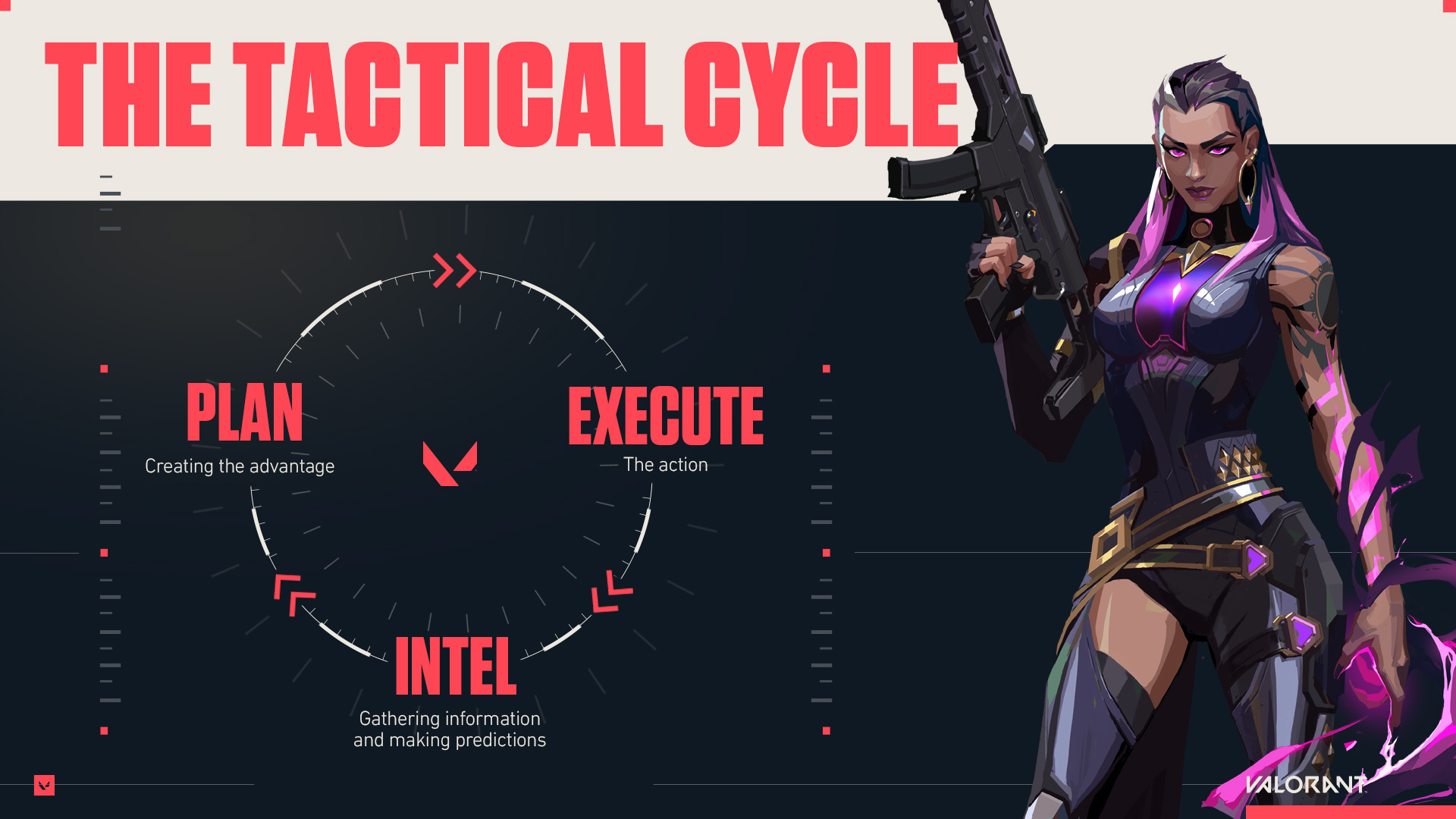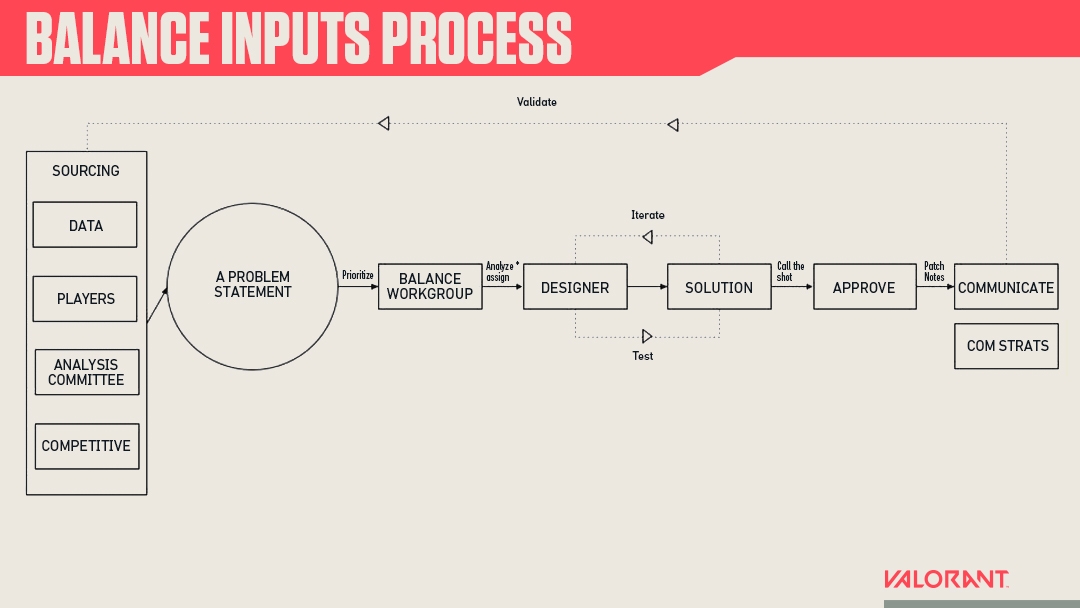Hey, it’s David ‘Milkcow’ Cole, VALORANT game designer. We shipped a game! We have a live game! And with going live to you, we now have a responsibility to maintain the live experience— most importantly—game balance.
From as far back as our Alpha, there has been a group of Content Designers, QA, and Insights setting up the foundations of game balance and health, so that when we hit the live phase of VALORANT (that’s now), we would have a rough understanding of what is healthy, overpowered, underpowered, etc. Hopefully this article will shed some light into how we’ve been approaching balance and where we want to end up.
BALANCE DO’S AND DON’TS
Game balance is something that every player feels and may have some opinions about. The experiences all of you have and feel shape your perceptions of the game—your perception is your truth. It’s our job to provide an experience that is fair for every player. With that being said, here’s what we will and won’t do:
- We’ll prioritize audiences that we think take the game in the right direction in its current state. We’ll have to make tradeoffs with which audience we’re aiming to balance for—it won't be every player
- We won’t make every player happy with our changes. Sometimes we’ll need to make or not make changes that go against what our players want for the greater game.
- We’ll rely on human judgement to contextualize game data. We won’t be entirely data driven.
- We won’t seek a perfect 50/50 balance. When everything is 50/50 across the board the decisions per session become less meaningful—you could say.. robotic and formulaic. The human element of making decisions provides decision points that players can weigh the tradeoffs of.
We’re holding true to our guiding principles—what we call “the tac cycle.” No matter what, the game must uphold the values of the tac cycle in order to be healthy.

A quick breakdown of the tac cycle: Intel → Plan → Execute → Repeat.
- Intel
- Who and where are your opponents?
- What has taken place up to the current state of the game?
- What territory of the map do we own? Do the opponents own?
- Which Agents, abilities and guns are in play?
- What have your opponents done previously?
- Plan
- With the information we’ve gathered from intel what is my plan?
- Execute
- Timing
- Coordinating to implement the plan
- Abilities
- Critical part of reducing the risk of your plan
- Shooting
- Click heads to close out engagements.
- Timing
VALORANT is a game where every decision in this loop matters. You are aware of the decisions you’ve made and their outcomes. You can have the perfect intel and plan, but mechanically fail to execute. You can have no plan, yet win by mechanically executing the impossible. Your skill matters.
It's important that this loop happens for every player at every level of play. It starts when you find a match and your map is shown, the characters you pick as a composition, the round you're about to play, and when you’re in that 1v2 clutch on B site.
BALANCE RADAR
Our group has been working to set up a process for how we make decisions and gather information over the last 6 months—kind of like building our own balance radar. This has consisted of creating a process of diverse information inputs.

On the balance group, we have three primary sources of information that we take in to inform our decisions. Each of them are incredibly important to help to determine whether the live state of the game is healthy or whether we need to intervene and nudge it back on track.
-
Game Data: These are data that tell us what’s actually happening in the game on any given patch - match winrates, defender/attacker round winrates, agent pickrates, weapon purchase rates, etc. It paints the picture for us from which to make decisions.
-
Sentiment Data: While we are committed to ensuring VALORANT is a balanced game for our players, we also want to make sure that we’re creating an experience that is enjoyable for players overall. To ensure we’re meeting our goals here, we send player surveys periodically to understand how they feel about the current state of the game: what’s fun, what’s frustrating, etc. This helps us interpret game data, but also lets us understand if there are experience issues that aren’t represented in the game data.
- Design Philosophy: Finally, the balance team leverages its own design philosophy when making decisions to drive the game towards what we feel is the right direction. Ultimately, game and sentiment data help us understand the state of the game and our playerbase on any given patch, but our design philosophy fundamentally informs how we feel about that state—it defines the goals we’re aiming to hit.
During our time together as a balance group, we’ve used a combination of game data, sentiment data, and our design philosophy to align on a set of “bounds.” Think of them as borders—when our metrics live inside the borders, we feel the game is fairly healthy. If something dips outside of these borders, it raises a flag and we investigate. We’re not ready to share the numbers of these bounds yet, but the graph below has an example of how we think about bounds on different types of content.
These are examples of statements, not true facts!
ALERTS |
Agent overall |
Agent by map |
Agent by side |
Start side winrate |
Round side winrate |
Upper bounds |
“Sage is busted” |
“Raze on Split is too strong” |
“Cypher is too good on defense” |
“If I start on attack on Split I have a higher chance of winning the match” |
“Split is too defender-sided” |
Lower bounds |
“Viper is trash” |
“Jett is bad on Bind” |
“Cypher can’t do anything on offense” |
Weapons. Where do I begin? Weapons are incredibly complex when contextualized in-game. The data itself does not tell you the story of their impact and we’re still figuring out the exact details of them.
Another part of this process is developing a voice and communicating our changes and reasons in patch notes:
And lastly, we embed ourselves into the ecosystem. We have people on the team playing at a high level, communicating with key individuals for feedback and constantly reading any feedback we can get.
CASE STUDY: RAZE
Here’s an example of how all the above pieces come together: Raze was released as strong vs other Agents and lots of vocal sentiment grew about her existence in VALORANT.
This is how the team used the steps above to get to our changelist for Raze in the .47+ patch.
- Excal, Morello, and the rest of our balance group were aligned that Raze’s kit fits the tac cycle and did not break the loop. She was one of our first kits that this project had designed, and she had helped shape the cycle itself.
- We immediately looked at the data. She had a high match win rate of ~51% and 53.5% in non-mirrored matches, especially on defense against enemies that were grouped up charging her position. This did not trigger our initial alerts that we had set in Closed Beta. We quickly realized that power in our game was in the measures of .1%’s rather than 1%’s. We tightened the bands later on as the conversations internally around Raze were that she was OP relative to other Agents.
- We looked at player sentiment. Streams, surveys, anecdotes, forums—anything we could find. There was a lot of frustration about being rocketed and naded but when we dug into it, we realized that players were not reacting to the audio cues of her abilities and had a hard time understanding what was happening to them outside of the fact that they were now dead.
- Excal did an analysis writeup with the information we had acquired and proposed some changes:
- Having two grenades that she could throw back to back created an oppressive scenario for players trying to push into her. Raze players were getting a lot of kills which in turn gave her access to her Ultimate more often.
- Players were not reacting to the counterplay cues of her abilities which caused more frustration.
- We made changes and tested them internally.
- Grenade charges went from 2 to 1 and became a reset on kill. This change lowered the frequency in which opponents would run into the nades but still give the Raze player the opportunity to continually blow stuff up. It was a great change that fit her core identity—kill them.
- The audio attenuation of her Rocket fire and equip were changed drastically to really tell players that they needed to vacate the area.
- We put them into the patch notes and added context to our reasonings.
- We monitored the player's reaction and sentiment to the patch notes. They liked the direction we were taking her but were still skeptical about Raze in general. Her win rate directly took a hit but not by much. Yet, the perception was that she is in a much more balanced state.
- We followed up in later patches using the direction we had set in .47+.
There have been countless amounts of iteration on all of these pieces above to get them to where they are today and we’ll continue to evolve these as we learn how you're playing VALORANT.
Thank you for reading my Dave Talk and if you enjoyed reading, there’s more to come in the future!